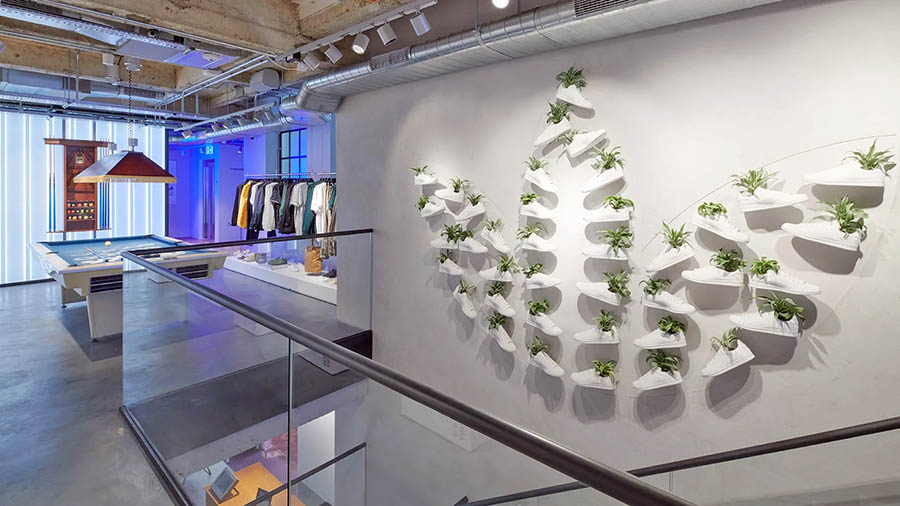Adidas posted a 1 percent increase in currency-neutral (c-n) revenues in the third quarter of 2023. The company said the top-line development reflected the company’s conservative sell-in approach aimed at reducing high inventory levels, improved sell-through as well as the company’s focus on full-price sales across its own channels.
In euro terms, the company’s revenues declined 6 percent to €6.00 billion in the third quarter, compared to €6.41 billion in q3 last year.
Adidas third quarter revenues were also said to be impacted by the sale of parts of its remaining Yeezy inventory. The second product drop generated revenues of around €350 million in Q3, which was said to be somewhat below the Yeezy sales generated in the 2022 third quarter. As a result, excluding the Yeezy revenues in both years, currency-neutral revenues increased 2 percent during the quarter.
- Currency-neutral sales in North America declined 9 percent during the quarter (-10 percent excluding Yeezy revenues in both years). The region was said to be “particularly affected” by elevated inventory levels in the market and the company responded to the issue that it had significantly reduced sell-ins to retailers. As a result, wholesale revenues were down double digits in the region, whereas DTC sales increased versus the prior-year quarter.
- Greater China revenues grew 6 percent (c-n) in Q3 (+10 percent excluding Yeezy), driven by double-digit growth in wholesale.
- EMEA Currency-neutral sales increased 2 percent (+2 percent excluding Yeezy), reflecting high-single-digit growth across the company’s own distribution channels.
- Asia-Pacific revenues increased 7 percent (c-n) in the third quarter (+5 percent excluding Yeezy). Strong double-digit DTC growth reflects the strong sell-out trend Adidas is enjoying in the region.
- Latin America revenues increased 13 percent (c-n), or +12 percent excluding Yeezy, reflecting strong growth in both wholesale and DTC.
Demand for Lifestyle Footwear Drives Originals
Footwear revenues grew 6 percent in the quarter on a currency-neutral basis, reflecting double-digit growth in Adidas Originals as well as in the football and basketball categories.
Apparel sales declined 6 percent in the third quarter.
Revenues in the company’s outdoor and basketball categories grew at strong double-digit rates.
Apparel sales in the football (soccer) category were down versus last year’s strong sell-in prior to the FIFA World Cup. In addition, the company continued its conservative sell-in strategy as the apparel market faced particularly high inventory levels. Accessories revenues were down 3 percent during the quarter.
The Adidas Lifestyle categories increased sales during the quarter as extraordinary demand for the company’s Samba, Gazelle, Spezial, and Campus franchises led to a return to growth in Adidas Originals.
Adidas Performance categories continued to experience strong momentum for many of its new product introductions such as the latest iterations of its Predator, X and Copa football boots as well as the next generation of the Terrex Free Hiker outdoor shoes. In running, the introduction of the Adizero Adios Pro EVO 1 led to record-breaking performances at marathon races. In addition, it continued to generate a lot of attention and strong demand for the entire Adizero product family. This excitement reportedly translated into strong double-digit growth for the franchise during the quarter.
Conservative Sell-In and Focus on Full-Price Business
As a result of the company’s initiatives to reduce high inventory levels, currency-neutral sales in wholesale declined 2 percent despite double-digit growth in Greater China and Latin America. At the same time, DTC revenues grew 5 percent versus the prior year. This growth was said to be driven by strong growth in the company’s owned retail stores (+10 percent c-n), reflecting continued strong sell-out trends. The Adidas e-commerce business also continued to grow in the quarter (+1 percent c-n). The company successfully focused on reducing discounting activity and improving the overall business mix. As a result, Adidas said that full-price sales generated through the company’s own e-commerce platform increased at strong double-digit rates, leading to strong improvements in the full-price share across all markets.
Income Statement
The company’s third-quarter gross margin increased 20 basis points to 49.3 percent of sales, compared to 49.1 percent in Q3 last year. The improvement was mainly driven by reduced freight costs, a more favorable business mix, as well as lower inventory allowances. Unfavorable currency movements reportedly weighed “strongly” on the gross margin development during the quarter. Discounting levels improved significantly compared to the first half and second quarter of the year.
Operating profit of € 409 million, resulting in an operating margin of 6.8 percent. Other operating expenses were down 4 percent to €2.57 billion in Q3. As a percentage of sales, other operating expenses increased 1.1 percentage points to 42.8 percent of sales.
Marketing and point-of-sale expenses decreased 7 percent to €644 million. As a percentage of sales, marketing and point-of-sale expenses slightly decreased to 10.7 percent from 10.8 percent in the year-ago period.
Operating overhead expenses declined 3 percent to €1.93 billion. During the quarter, the company recorded one-off costs of around €80 million related to the strategic review the company is currently conducting as well as donations and accruals for further donations in an amount of around €30 million. As a percentage of sales, operating overhead expenses increased 110 basis points to 32.1 percent.
Operating profit for the third quarter amounted to €409 million, compared to €564 million in the 2022 corresponding quarter. This amount includes the extraordinary expenses of in total around €110 million reflecting the one-off costs related to the strategic review as well as the donations and accruals for further donations.
The sale of the Yeezy product positively impacted Adidas’ operating profit by an incremental amount of approximately €150 million in the third quarter. The operating margin reached 6.8 percent in the quarter, down 200 basis points compared to 8.8 percent in Q3 2022.
Net income from continuing operations of €270 million, compared to €66 million in the year-ago quarter, while basic EPS from continuing operations improved to €1.40 from €0.34 in Q3 last year.
Inventories Improve Strongly, Operating Working Capital Declines
Adidas’ initiatives around inventory management, including significantly reducing buying volumes and tactically repurposing existing inventory, are said to be paying off.
Inventories continued to improve strongly during the third quarter with ear-over-year inventories now down 23 percent to €4.85 billion at quarter-end. On a currency-neutral basis, inventories declined 19 percent compared to the prior year’s quarter-end period.
During the first nine months of the year, the company’s inventory level declined by more than €1.1 billion.
Operating working capital declined 10 percent to €5.56 billion year-over-year. On a currency-neutral basis, operating working capital decreased 4 percent. In addition to the strong inventory decline, this development was said to reflect a significant decrease in receivables as a result of the company’s conservative sell-in approach as well as a strong double-digit decrease in payables due to lower sourcing volumes in line with the company’s activities to reduce elevated inventory levels. Average operating working capital as a percentage of sales increased to 26.9 percent versus 22.2 percent in the year-0ago period.
Adjusted Net Borrowings Declined to €5.24 billion
Adjusted net borrowings at quarter-end amounted to €5.24 billion, compared to €5.51 billion at the 2022 third quarter-end, representing a year-over-year decline of 5 percent. This development mainly was said to reflect a decline in lease liabilities as well as an increase in cash and cash equivalents. Compared to the 2022 year-end level, adjusted net borrowings declined by more than €800 million.
Full-Year Outlook
On October 17, Adidas adjusted its full-year financial guidance to reflect both the positive impact of the second drop of some of its Yeezy inventory and the better-than-expected development of the underlying business. At the same time, the company said that macroeconomic challenges and geopolitical tensions persist. Elevated recession risks in North America and Europe as well as uncertainty around the recovery in Greater China continue to exist. In addition, the company’s revenue development will continue to be impacted by the initiatives to significantly reduce high inventory levels in North America and the company’s focus on full-price sales across its own channels.
As a result, Adidas now expects currency-neutral revenues to decline at a low-single-digit rate in 2023, compared to prior guidance of a decline at a mid-single-digit rate.
The company’s underlying operating profit, excluding any one-offs related to Yeezy and the ongoing strategic review, is now anticipated to reach a level of around €100 million in 2023, compared to previous expectations at around a break-even level.
Including the positive impact from the two Yeezy drops in Q2 and Q3 of around €300 million, previously €150 million, the potential write-off of the remaining Yeezy inventory of now around €300 million versus the €400 million level previously expected and one-off costs related to the strategic review of up to €200 million, Adidas now expects a reported operating loss of around €100 million in 2023, compared to its previous estimates of a loss of € 450 million.
Photo courtesy Adidas/Oxford Street
















